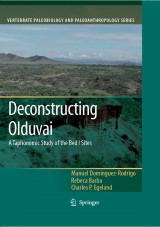Details

Deconstructing Olduvai: A Taphonomic Study of the Bed I Sites
Vertebrate Paleobiology and Paleoanthropology
|
53,49 € |
|
| Verlag: | Springer |
| Format: | |
| Veröffentl.: | 05.07.2007 |
| ISBN/EAN: | 9781402061523 |
| Sprache: | englisch |
| Anzahl Seiten: | 339 |
Dieses eBook enthält ein Wasserzeichen.
Beschreibungen
Plio-Pleistocene sites are a rare occurrence in same sites. This combination of factors is the archaeological record. When they are unique in East African Plio-Pleistocene uncovered, the faunal materials so crucial to archaeology and has stimulated much debate unlocking their behavioral meaning are often over the socioeconomic function of early sites. poorly preserved. For example, at Koobi Fora, Influential models of early hominid behavior Kenya, a prolific region that preserves several in the late 1960s and early 1970s were based classic Plio-Pleistocene sites, many bones are exclusively on information from Olduvai affected by poor cortical surface preservation Gorge (Leakey, 1971). Although Isaac’s (e. g. , (Isaac, 1997). Such taphonomic vagaries limit 1978) work at Koobi Fora expanded their the range of questions that can be addressed application, the subsequent critiques, modi- with these assemblages. In other instances, cations, and reformulations of these models access to materials can be limited due to local were based almost solely on studies from politics or rivalries between individual Olduvai (Binford, 1981, 1984; Bunn, 1981; research teams. As a result, many important Potts, 1982, 1988; Bunn and Kroll, 1986; assemblages either remain unstudied or have Blumenschine, 1995; Rose and Marshall, been interpreted without the advantage of a 1996; Domínguez-Rodrigo, 1997a, 2002; fully developed taphonomic framework, a sit- Plummer, 2004). Having said that, it is also uation that all but guarantees stagnant inter- clear that continued work at Koobi Fora and pretations.
The “home base” debate.- The Hunting-versus-scavenging debate.- The “physical attribute” taphonomic approach.- Geological and paleoecological overview of Olduvai Gorge.- New estimates of tooth-mark and percussion-mark frequencies at the FLK Zinjanthropus level: the carn.- The behavioral meaning of cut marks at the FLK Zinj level: the carnivore-hominid-carnivore hypothesis falsified (II).- A cautionary tale about early archaeological sites: a reanalysis of FLK North 6.- A palimpsest at FLK North 1-2: independent carnivore- and hominid-made bone accumulations.- A taphonomic study of FLK North 3 and 4: a felid-hyaenid and hominid palimpsest.- Zooarchaeology and taphonomy of FLK North 5.- Natural background bone assemblages and their ravaging stages in Olduvai Bed I.- FLK North North 1: “living floor” or natural accumulation?.- Zooarchaeology and taphonomy of FLK North North 2.- Reanalysis of FLK North North 3: yet another case of a palimpsest?.- Zooarchaeology and taphonomy of the DK site.
<P><STRONG>Manuel Domínguez-Rodrigo</STRONG> is a professor of Archaeology in the Department of Prehistory of the Complutense University, Madrid. He is co-editor of Journal of Taphonomy. He has been the head of research projects on human evolution conducted in Peninj, Eyasi and Olduvai Gorge (Tanzania), as well as having participated in research conducted in Gona (Ethiopia) and Swartkrans (South Africa). He is associate researcher of the National Museums of Kenya.</P>
<P></P>
<P><STRONG>Rebeca Barba</STRONG> got her doctorate in Archaeology in the Complutense University under the supervision of MDR. She has conducted research in Peninj and Olduvai. He is associate researcher of the National Museums of Kenya.</P>
<P></P>
<P><STRONG>Charles P. Egeland</STRONG> recently recieved his Ph.D. in Anthropology from Indiana University in Bloomington. In addition to his work in Tanzania, he has conducted field and lab research in South Africa, Kenya, Germany and several U.S. states.</P>
<P></P>
<P><STRONG>Rebeca Barba</STRONG> got her doctorate in Archaeology in the Complutense University under the supervision of MDR. She has conducted research in Peninj and Olduvai. He is associate researcher of the National Museums of Kenya.</P>
<P></P>
<P><STRONG>Charles P. Egeland</STRONG> recently recieved his Ph.D. in Anthropology from Indiana University in Bloomington. In addition to his work in Tanzania, he has conducted field and lab research in South Africa, Kenya, Germany and several U.S. states.</P>
A revolutionary analysis of the oldest archaeological sites of Olduvai Gorge showing that current models of reconstruction of human behavior are wrong Offers a new analytical approach to understanding how early archaeological sites were formed

















